Believe it or not, there are more than 50 types of nuts scattered around the world (though only about 20-ish are considered edible for humans).
As a whole, nuts are an incredibly nutrient-dense food with some amazing— but frequently overlooked— health benefits. They are filling, rich in protein, and a great source of healthy, plant-based fats.
Here’s more about what makes nuts so good for you, plus the 10 healthiest nuts you can eat.
What’s So Great About Nuts?
Nuts are defined as edible seed kernels that are encased in a very hard shell. This sets them apart from other types of seeds, like pumpkin or sunflower seeds, that grow inside a fruit or have a softer shell.
(So, technically, all nuts are seeds but not all seeds are nuts— in case you ever want to impress someone with your knowledge.)
Regardless of the technical definition, the seeds we commonly refer to as nuts share similar characteristics, though each nut has its own unique benefits.
For example, most nuts are a great source of fiber, protein, and fat. This combination provides long-term energy, helps you to feel full and satisfied, and may help with weight loss or management. Nuts are also a heart-healthy food that may even contribute to a lower risk of heart disease.
In addition, nuts are rich in antioxidants, minerals, and omega-3 fatty acids that help keep your skin and entire body healthy.
The bottom line is that if you don’t already eat nuts regularly, you should start doing so! Especially the top choices to follow…
10 Healthiest Nuts to Eat
Almonds
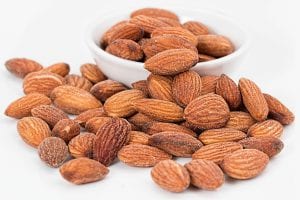
Almonds have a lot going for them. One of their most outstanding properties is the high amount of vitamin E they contain (the highest of any nut). In fact, just a one-ounce serving of almonds contains about 45% of the daily value (DV) for vitamin E.
Vitamin E is an important antioxidant nutrient. It helps to protect your cells from free radical damage and is essential for healthy-, young-looking skin. Consuming it via almonds may even help reduce the appearance of wrinkles.
Besides vitamin E, 1 ounce of almonds also contains:
- Fat: 15 grams
- Protein: 6 grams
- Fiber: 3 grams
- Manganese: 27% of the DV
- Magnesium: 19% of the DV
- Calcium: 7% of the DV
Studies have shown that regularly eating almonds can help lower LDL (bad) cholesterol levels as well as certain inflammatory markers and HbA1c. The fiber in almonds also promotes digestive health, in part by supporting the growth of good bacteria in your gut.
Walnuts
Walnuts definitely top the list of healthiest nuts for your brain.
They contain powerful antioxidants with anti-inflammatory properties that have been shown to decrease neuroinflammation. Plus, walnuts are exceptionally rich in copper (50% of the DV in a 1-ounce serving), which plays a key role in neurotransmitter synthesis.
Because of this, several studies indicate that eating 1-2 ounces of walnuts per day may reduce some risk factors for dementia and helps protect brain function.
Along with antioxidants and copper, 1 ounce of walnuts also contains:
- Fat: 18.5 grams
- Protein: 4 grams
- Fiber: 2 grams
- Manganese: 42% of the DV
- Magnesium: 11% of the DV
- Vitamin B6: 10% of the DV
Like many other nuts, walnuts are also good for your heart. Studies have found that they may help lower blood pressure, LDL (bad) cholesterol, and triglycerides.
As a bonus, walnuts are one of the best sources of alpha-linolenic acid (ALA)— the essential plant-based omega 3 fatty acid.
Pistachios
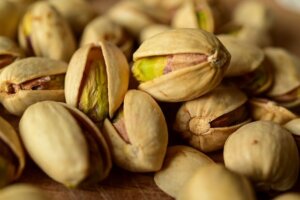
Pistachios have the distinction of being a complete protein source, meaning they contain all the essential amino acids. This is somewhat rare in plant foods and makes pistachios one of the best plant-based proteins.
Pistachios are also lower in fat and calories than most other nuts AND are one of few nuts to contain substantial amounts of lutein and zeaxanthin. These two compounds belong to a group of antioxidants known as carotenoids and are essential for healthy vision.
Here are some other important nutrients in a 1-ounce serving of pistachios:
- Fat: 13 grams
- Protein: 6 grams
- Fiber: 3 grams
- Vitamin B6: 28% of the DV
- Vitamin B1: 21% of the DV
- Magnesium: 8% of the DV
- Iron: 6% of the DV
- Potassium: 6% of the DV
A few studies have even found that eating pistachios may boost brain function, improve gut health, and help with weight loss.
Fun Fact: The word “pistachio” is derived from the Greek word pistákion, meaning “the green nut.”
Cashews
Cashews are particularly rich in magnesium, which is an essential mineral many people fall short on. Magnesium plays a key role in sleep quality, mood, and brain health and is also necessary for proper muscle and nerve function.
Along with vitamin D and calcium, magnesium is critical for keeping your bones strong and healthy as well. This makes cashews one of the healthiest nuts for your bones, especially because they also contain vitamin K, which has been linked to a lower risk of bone fractures.
Here’s an overview of what else you’ll get from 1 ounce of cashews:
- Fat: 12 grams
- Protein: 5 grams
- Fiber: 1 gram
- Magnesium: 20% of the DV
- Manganese: 20% of the DV
- Iron: 10% of the DV
- Vitamin K: 8% of the DV
Some studies have shown that cashews may be particularly beneficial for lowering blood pressure. Consuming them regularly could also help reduce other risk factors for heart disease, including triglycerides and cholesterol levels.
Pecans
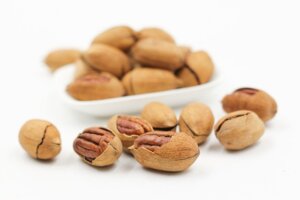
Pecans contain an energy-boosting mixture of healthy fats and protein as well as fiber that promotes healthy digestion.
They are also fairly rich in zinc, which is an essential mineral needed by your body for immune function and DNA synthesis as well as clear, youthful-looking skin. It has shown acne-fighting properties in studies and even demonstrated an ability to help protect skin from damaging UV rays.
Overall, a 1-ounce serving of pecans contains:
- Fat: 21 grams
- Protein: 3 grams
- Fiber: 3 grams
- Manganese: 48% of the DV
- Zinc: 13% of the DV
- Vitamin B1: 11% of the DV
- Magnesium: 8% of the DV
Pecans are also richer in antioxidants than many other nuts. They are especially high in a specific form of vitamin E known as gamma-tocopherols.
One study linked this excellent antioxidant content to major benefits for heart health, including 16.5% lower levels of LDL (bad) cholesterol following a “pecan-enriched diet.” Newer studies have confirmed these results and found that pecans may help lower triglycerides, too.
Hazelnuts
Hazelnuts are very nutritious and much of their fat content is of the heart-friendly, monounsaturated kind. Like pecans, they are extremely rich in antioxidants, which is one of the reasons they sit on the list of healthiest nuts to eat regularly.
Hazelnuts contain a fair amount of vitamin E, which you may remember is a powerful antioxidant. They also pack in other antioxidants like quercetin, epicatechin, caffeic acid, and gallic acid. This combination gives them a powerful ability to combat inflammation and fight free radical damage.
Eating an ounce of these nuts provides:
- Fat: 17 grams
- Protein: 4 grams
- Fiber: 3 grams
- Manganese: 76% of the DV
- Vitamin E: 28% of the DV
- Magnesium: 11% of the DV
- Potassium: 4% of the DV
As you can see, hazelnuts also contain a high amount of manganese. You don’t often here much about manganese, but it’s an important trace mineral that is needed for a healthy brain, nervous system, and bones. It also forms part of one of the most important antioxidants in your body: superoxide dismutase (SOD).
Brazil Nuts
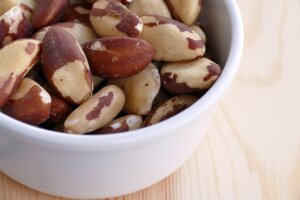
Brazil nuts are most notable for their selenium content. In fact, eating just 1-2 of these nuts (which are fairly large) will get you all the selenium you need for a day!
Selenium is a trace mineral that acts like an antioxidant within your body. Your body needs it for DNA synthesis, and it’s especially critical for proper thyroid function and hormone balance. Selenium is essential for your skin, too, where it helps protect against UV damage.
Here’s what a 1-ounce serving of Brazil nuts contains:
- Fat: 19 grams
- Protein: 4 grams
- Fiber: 2 grams
- Selenium: 989% of the DV
- Magnesium: 25% of the DV
- Vitamin E: 11% of the DV
- Calcium: 4% of the DV
Keep in mind that it is possible to consume too much selenium, which can lead to symptoms like diarrhea, nausea, and skin rashes. This is much more likely to happen with selenium from supplements rather than whole foods, but you still may want to limit your intake to a few Brazil nuts a day.
Macadamia Nuts
Despite having a fairly high fat content, macadamia nuts are absolutely one of the healthiest nuts you can eat. Remember, nuts contain a lot of unsaturated fat, which is much more heart-friendly and healthy than the saturated fat you would find in red meat, for example.
As a case in point, studies have shown that macadamia nuts are comparable to other tree nuts at lowering total and LDL (bad) cholesterol levels. They can also help lower triglycerides and may improve both HbA1c and blood sugar levels.
An ounce of macadamia nuts is rich in nutrients like:
- Fat: 21.5 grams
- Protein: 2 grams
- Fiber: 2.5 grams
- Manganese: 51% of the DV
- Vitamin B1: 28% of the DV
- Copper: 24% of the DV
- Magnesium: 8% of the DV
Of course, another benefit of the higher fat content of macadamia nuts is that it gives them a buttery texture and delicious flavor.
You can even use them to make a creamy, homemade nut butter with zero added sugar. Just blend the nuts with a pinch of sea salt in a food processor until smooth. (Add a bit of raw honey if you do prefer a little sweetness.)
Chestnuts
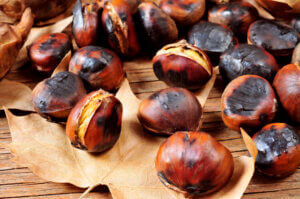
If you’ve never tried chestnuts before, put them on your list! This holiday favorite is one of the lowest fat nuts you’ll find and is packed full of both vitamins and minerals.
Here’s a look at all a 1-ounce serving of chestnuts (roasted) contains:
- Fat: 0.6 grams
- Protein: 0.9 grams
- Fiber: 1.4 grams
- Copper: 16% of the DV
- Manganese: 14% of the DV
- Vitamin B6: 8% of the DV
- Vitamin C: 8% of the DV
- Vitamin B1: 6% of the DV
- Folate: 5% of the DV
In addition to this already impressive nutrient profile, chestnuts contain lower amounts of potassium, magnesium, vitamin K, vitamin B5, and vitamin B6. Eating them raw ups the vitamin C content to almost 13% of the DV.
Chestnuts are also surprisingly rich in antioxidants, including polyphenols, lutein, and zeaxanthin. This means they may help protect your vision and keep you healthy as you age.
Peanuts
Technically, peanuts aren’t nuts at all. They belong to the legume family (the same one as peas and beans) and grow underground rather than in trees like the rest of the nuts mentioned.
Still, since peanuts do have the word “nut” in their name, they made it on this list of healthiest nuts because of their fairly significant health benefits.
One top peanut benefit is their ability to help lower cholesterol levels and improve other measures of heart health (including triglycerides). In fact, one large study found that eating either peanuts or tree nuts at least twice a week could lower the risk of heart disease by up to 19%.
Interestingly, peanuts are also rich in compounds that may have stress-relieving and brain-boosting properties. They are an excellent source of folate and contain other essential nutrients (per a 1-ounce serving):
- Fat: 13.5 grams
- Protein: 7 grams
- Fiber: 2.5 grams
- Vitamin B3: 23% of the DV
- Vitamin B9 (folate): 17% of the DV
- Magnesium: 12% of the DV
- Iron: 7% of the DV
Note: Choosing USDA Certified Organic nuts is always the best option to minimize your exposure to pesticide residue. However, this is especially important in the case of peanuts. They are frequently rotated in the field with cotton, which is a glyphosate-heavy crop, and are one of the most contaminated crops where pesticides are concerned.
How Many Nuts Should You Eat?
There’s no one-size-fits-all answer to how many nuts you should eat each day. Most studies indicate that 1-2 ounces of nuts per day (or at least 4-6 ounces per week) is a good range to get the maximum amount of benefits.
The exception to this, of course, is Brazil nuts, which are best consumed in smaller amounts due to their high selenium content.
Generally speaking, an ounce of nuts is about a handful. Depending on the size and weight of the nuts, an ounce is also the equivalent of around 1/5-1/4 of a cup.


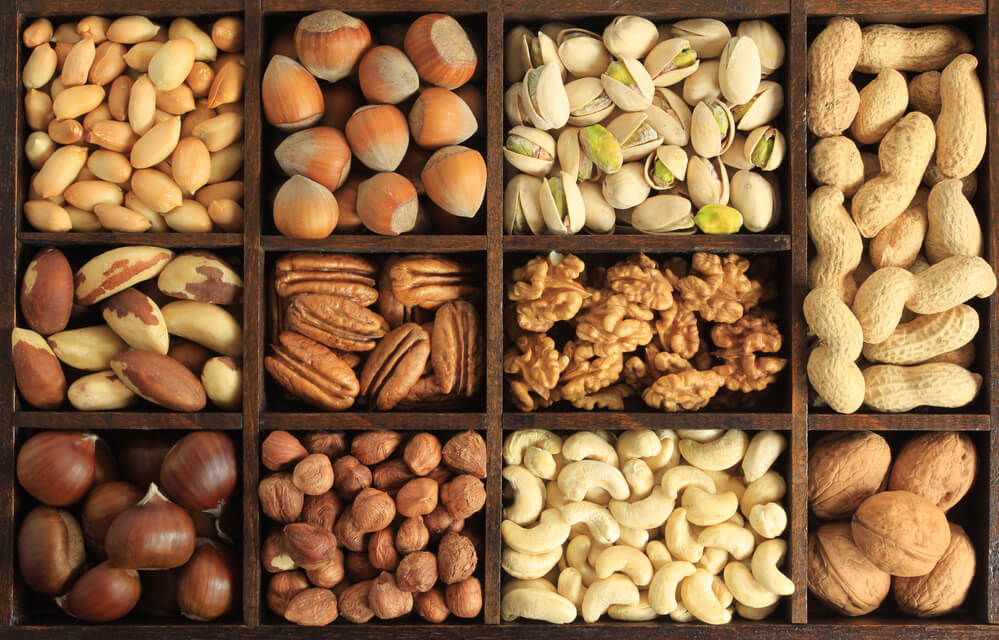

I consume nuts each day on musely and with fruit salad I enjoyed your article finding it very informative as to vitamin and mineral content I am now better informed and will add a few of the verities I do not consume now. Thank you for such a useful article.
I keep all my nuts in the freezer and buy them at a place that is normally wholesale by 1/4, 1/2 or 1 kilo. I tell my taxi driver, I need to go to the nut house. They say you are what you eat, so I am half nuts!
You are so funny!
Hello,
I eat a lot of nuts, too. So, I guess this makes me half nuts as well. Lol! 🙂
Thank you for the information on the nuts. It’s very informative .
You can find them referenced right under pistachios.
Good article but what happened to cashews? I see them in the photo but not the list.
They are there, you must have skipped over them.
But there’s no photo so if you were using the photos to guide you, you might have scrolled by. 🙂
Awesome!! Thank you so very much!! Bj
They are #4 in the list!
#4 on the list
They are 2nd after pistachios
They are there, just with no picture.
Excellent information, concise, great explanation of benefits with added warning about cautions if warranted. Thank you , excellent guide. I Appreciate it.
Never get nuts fried or roasted in seed oils. Always organic and raw. Dry roast them yourself.
Excellent article Brian!! Lots of great information.
Thank you!!
PS
Pretty good jokes too!!😅😂🤣
Loved this article so informative without any BS .
I will be following the advice from now on and will record my findings.
Thanks
JD
I appreciate this good information.
Fantastick info! Thank you🤗
Loved your top tips for nuts
and your dad jokes 😊🤗😊 thank you 🙏
I love nuts and now I know how to justify my habit.
enjoyed the article on the health benefits of nuts but you didn’t recommend if they need to be eaten raw or if roasted are as good as. I eat a lot of roasted nuts and always feel a little bit guilty about it
Thank you! very helpful information.
Do nuts have to be eaten raw or does roasting them do anything to them? Also what about roasted and salted nuts? Thank you for all you do.
In a book written by Sally Fallon (Weston Price Institute) called “Nourishing Traditions”, she explains that nuts contain phytates that require certain nutrients to buffer the digestion of the nuts. She recommends soaking the nuts for about 4 hours (If I remember correctly…. I use at least 4 hours, sometimes it’s longer if I get busy with other things) to neutralize the phytates. No one wants to eat soaked nuts so the next step is to drain and rinse them. Then dry them at low heat. I use my oven lights and put the nuts on a non-fuzzy tea towel on a cookie sheet to do this. This will take about a day, more or less. Some nuts will stain the tea towel – nuts are sources of natural fabric dyes. I eventually bought a length of muslin at a fabric store to use.
This sounds like a lot of work, but it takes a couple of minutes to set the nuts soaking, a minute (mostly looking for the colander) to drain and rinse the nuts and about 2 minutes to evenly spread them on a cookie sheet. The rest of the time is your own.
The book is about the traditions (either original or current ones) used by isolated populations or by populations that held on to their ancestral food preparation methods. It’s a fascinating book and includes recipes. It’s quite entertaining as well as informative. And you can bounce around from section to section. I highly recommend it.
Very helpful information, I have the book but needed direction to it. Thanks
Thank you! That was exactly the info I was looking for in the article! Couldn’t find it there but in reader’s reviews!
Very important info! I’m surprised it was missed!
Thank you again, Debbie
This is a really helpful listing and explanation. I eat tons of nuts (well, not quite a ton) every day. LOVE them! Also I’m very healthy. Plenty of protein and other needs of the body, with no meat. I choose to be vegan. It all works for me in wonderful ways. The only nut I have not been including in my daily nut breakfast is hazelnut. Will add it, too, now. Such a delicious, crunchy, filling and satisfying breakfast! Now I understand even more why!
Great information! I can see a future where following your recommendations for daily consumption might remove my need to buy supplements. More money to buy more nuts! Thanks.
I did not know that it is wise to choose organic peanuts. Thanks for sharing that! I will refrain from buying the five pound bag at BJs and stick with the organic peanut butter.
Thank you for this invaluable article. I stopped eating peanuts because I thought they were bad for you, but thank you for pointing out the risk of pesticides if not organically grown. The raw nuts that I already consume on a daily basis are Cashews (my favourite), Brazils (but will reduce the daily amount of 4 having read your article), Walnuts, and Almonds. Occasionally I will add Pistachios, Pecans and Macadamia as the latter can be very expensive.
I had no idea of the benefits of Chestnuts
Again, thank you for putting this out there. I will certainly be sharing this article.
You might also want to know what I shared with the poster above you:
Don’t buy cheap peanut butter and if you can, find one that has third-party testing for mycotoxins, especially aflatoxin which is found in peanut butter made with moldy peanuts. It is carcinogenic!
Which pb would you recommend? Thx in advance!
As always very informative. Thank you for all you share including Dad jokes whi h make me smile 😃. I like to roast a batch of mixed nuts flavoured with some dry spices and a drizzle of maple . So delicious.
I have been eating 5 of the listed nuts daily for a couple years. Thank you for this article of the 10 best nuts to eat. I really believe they are great value to good health.
Cashews are technically seeds not nuts. They are the seeds of the cashew apple.
All nuts are seeds, but not all seeds are nuts.
In Brazil, many of these nuts aren’t readily available (e.g. walnuts, macadamia, pistachio). But Brazil nuts, cashews and peanuts are, as well as pecans and (a long time ago) chestnuts! I have to look back up the list to see which ones I missed, for this makes up half of the 10.
I missed hazelnuts and almonds. Almonds are available here. In fact, I eat them regularly. Hazelnuts I used to consume when I was in the Netherlands, years ago. Here I haven’t seen any! Actually I haven’t seen chestnuts since I ate them as a child. I don’t know whether they are available here nowadays.
Excellent article on nuts. Is there much nutritional difference between roasted & raw nuts?
I love nuts and eat a sone every day, always two brazils and about four walnuts and peanut butter. I would love to add the others daily but I am always concerned about the high calorie content.
Thank you for a very informative article, I will include more nuts in my diet from now.
Thank you for the information, I do eat 5 of those nuts , but having all the ingredients of each nut is very beneficial,
Great article getting the word out about the health benefits of nuts’
I’m rawfoodist vegan, I have been eating nuts for years.
87 and fit and healthy.
Very important information
Thanks for the information.
Thank you for the new nutty details – Pecans – now to be added for ymm nutrition and caution with Brazils. Paul Pitchford in Healing With Whole Foods writes of a caution with Walnuts: “Walnuts often harbor liver flukes; roasting and other methods of cooking make them safe to eat” . Immensely grateful for all the nutritional vibrancy from The Art of Anti-Aging…
I think the walnuts = liver flukes idea was in Pitchford’s earlier editions and has since been removed.
Hi! I was surprised to see that peanuts have the most protein. Always liked nuts, just about all of them. Besides being nutritious, they are also very tasty. One can’t duplicate that good taste.
They are also versatile, separately or in dishes. Thank you for the information.
Can you eat too many nuts? Like I eat many more than 2-3 oz of a mixed nut blend – How much is too much ?
Thanks, good information I do eat most
nuts and had no idea the benefits!
GREAT ARTICLE BRIAN, THE DAD JOKES ARE THE BEST EVERY DAY…THANKS FOR YOUR KNOWLEDGE ON EVERYTHING. HUGS, A.DRYDEN
Thank you for this article. We keep a variety of nuts (and dried fruits) in locking mason jars on our counter, so we can “graze” on them throughout the day. It help keep us nutty 🤣
Such a great article about the health benefits of nuts! Your tip about peanuts was very important and I did not realize the issues with crop rotation so thank you very much!
what about salted and oiled nuts? a lot of nuts on grocery shelfs have a lot of salt and are oiled, too.
Hi!
Love the jokes! For me, the thing that keeps me from having seeds and nuts as part of my diet is the experience of not being able to find them fresh. Usually they are rancid and make my digestion slow and the whole memory of nuts a negative one. Can you recommend where to find fresh ones?
Question: What difference does it make if they are raw compared to roasted?
I loved this article. What I found particularly interesting for me was the fact that almonds and macadamia nuts can lower my blood sugar, seeing that I have diabetes. I have actually been taking almonds every day now for quite a while, so this is good.
Thank you Brian,
What a wonderful information!I I will share it in my clinic with my clients!
Hannah (from the Netherlands)
I have to add to your jokes: What did one reader say after reading this? “This article is nuts!”
Brian, enjoyed the information and always enjoy eating organically grown nuts. Now I have to run to the store and buy a new supply. :0
Thank you for another interesting and informative article. I have found out the hard way that I can not eat hazelnuts, Brazil nuts or macadamia nuts. I can enjoy all others.
I’m a fan of nuts eat them everyday. I try to get organic one’s raw. So, so good. Thanks for the overview concerning nuts. Also, I eat them to keep my weight balanced due to losing to much weight, and mix my own mix trail.
Thank you
Wonderful article on nuts! I love them all and enjoyed knowing more information about each one.
Thank you for posting this!
I have switched from chips to nuts for snacks no. The problem is finding nuts not loaded with salt. Only Christmas brings mixed nuts in the shell for sale in our little grocery store. The rest of the year, buying the salted ones. Also, very enjoyable on salads.
Some of the nuts I buy are “lightly” salted, but I wonder it you could do a quick water rinse and let the nuts dry on a paper towel. I, too, have noticed that many nuts are sold salted.
7/3 We can eat all those 10 nuts daily by counting them,how many of each to limit the amount/day?What about unsalted?salted?raw?roasted?and make sure its free from all those toxins in food from the soil etc.Thought peanut is the worst and should be avoided.Folks with GI issues, should be cautious in consumptions, folks with allergies,folks with brittle teeth,(have to grind as many you like (in food mixer) and ad that with my gluten free,whole grain,non GMO,organic and all those free terms so to preserve your teeth(less chewing and easily digest and absorbs once reach GI which chemicals (enzymes)takes over the digestion process,yes mechanical (chewing) starts in the mouth (having dentures can be challenging).Excellent info about those 10 healthy nuts.
My doctor suggested I chew nuts thoroughly because I have couple of tiny gall stones. They aren’t an issue, but I don’t’ want future problems. So that’s definitely something to be aware of.
I’ve always been a good chewer, but am now doubling down on chewing my food even more. I’m 79 and have all my own teeth, and have always been careful about foods that were super sticky, like taffy, when I had fillings, or foods that are really hard. I think it makes sense to be aware of not breaking our teeth, especially as we age.
When we were children, my mom made a special point to have nuts and fruit to snack, especially around Christmas, when we find almonds and walnuts in their shells, along with tangerines, stuffed in our stockings, which I always resented, wishing for toys instead. (Plus it was really laborious to pry open those shells!)I knew in my heart though she was trying to promote healthy habits in us. Other nuts she’d provide were peanuts, occasionally (probably due to the higher price) filberts, cashews, and pistachios, all in their shells. Every Christmas I remember her by making sure I have tangerines and a variety of nuts for myself, although year-round my pantry is never lacking walnuts and almonds. Thank you for this great article Brian, which is inspiring me to expand my collection of nuts. I love your signature Dad jokes. Do you remember the Almond Joy/Mounds TV ads, with the jingle accompanying crazy actions (one was a bride in full gown/veil, picking up her husband to carry him over the threshold):”Sometimes you feel like a nut, sometimes you don’t!”
Very useful article and without endlessly long blah, blah, blah video.
Thank you so much!
A fantastic article which I will share
Any chance of the carb content
Being added to the table
As I’m keto and this is important ⁉️🤔
This was a great article – very informative and concise. I really have a longstanding issue with articles about how healthy nuts are; I am highly allergic to all nuts, including peanuts. I have gone into anaphylactic shock on many occasions and carry my Epi-Pen at all times. Do you have any suggestions for what I could substitute for nuts, in terms of the nutrition? I eat chia seeds every morning. Thank you!!
On a YouTube video about the five worst foods for glyphosate/round up levels, this Dr said Almonds were the worst which broke my heart! Is this true, tell me it isn’t so & if it is does the contamination come from the soil?
Think how horribly contaminated all our cotton clothing & bedding is because of the glyphosate/roundup! Why can’t we get this horrific toxin banned in our country?👿
Thank you Brian, I am concerned because I was told not to eat Almonds or consume the milk because of the oxalate content. Can you please explain a little more about Oxalates in any of these 10 on the list because I have stopped eating any nuts lately. Thanks again keep the jokes coming.
Thank you so much for the valuable information. I love nut, I just need to find out where to get the certified organic nits. I loved reading this but I especially liked telling the jokes to my husband.
Thank you for sharing! This article is very informative. As a raw vegan, nuts are a staple in my diet. There are a couple of nuts here I have not tried yet, but I will make it a point to do so.
Thanks again for sharing! (hands in prayer as I bow to you)
I knew nuts are very good brain and other parts of the body. It’s always good to keep up it. thanks
Thank you for this very informative article. I am a ‘nuts fan’. I have nuts daily. I add them to my morning smoothie – almonds, walnuts, cashew , .. a mixture.
Hi Brian! Thank you so much for this article. Now I have a greater understanding of what nuts to include in my trail mix.
We all enjoy reading your knowlage filled articles, Mr. Vaszily I feel that you are a sincere man who has empathy, keep up the good work. I heard that also acorns are a good choice of a edible nut and they also fulfill the botanic definition of what a true nut actually is, they’re are also nutritious, all the best.
I enjoy reading your article, very informative, which is someting treenut enthusiasts would find beneficial.
Thank you for the details about each nut; I’m on the right track!